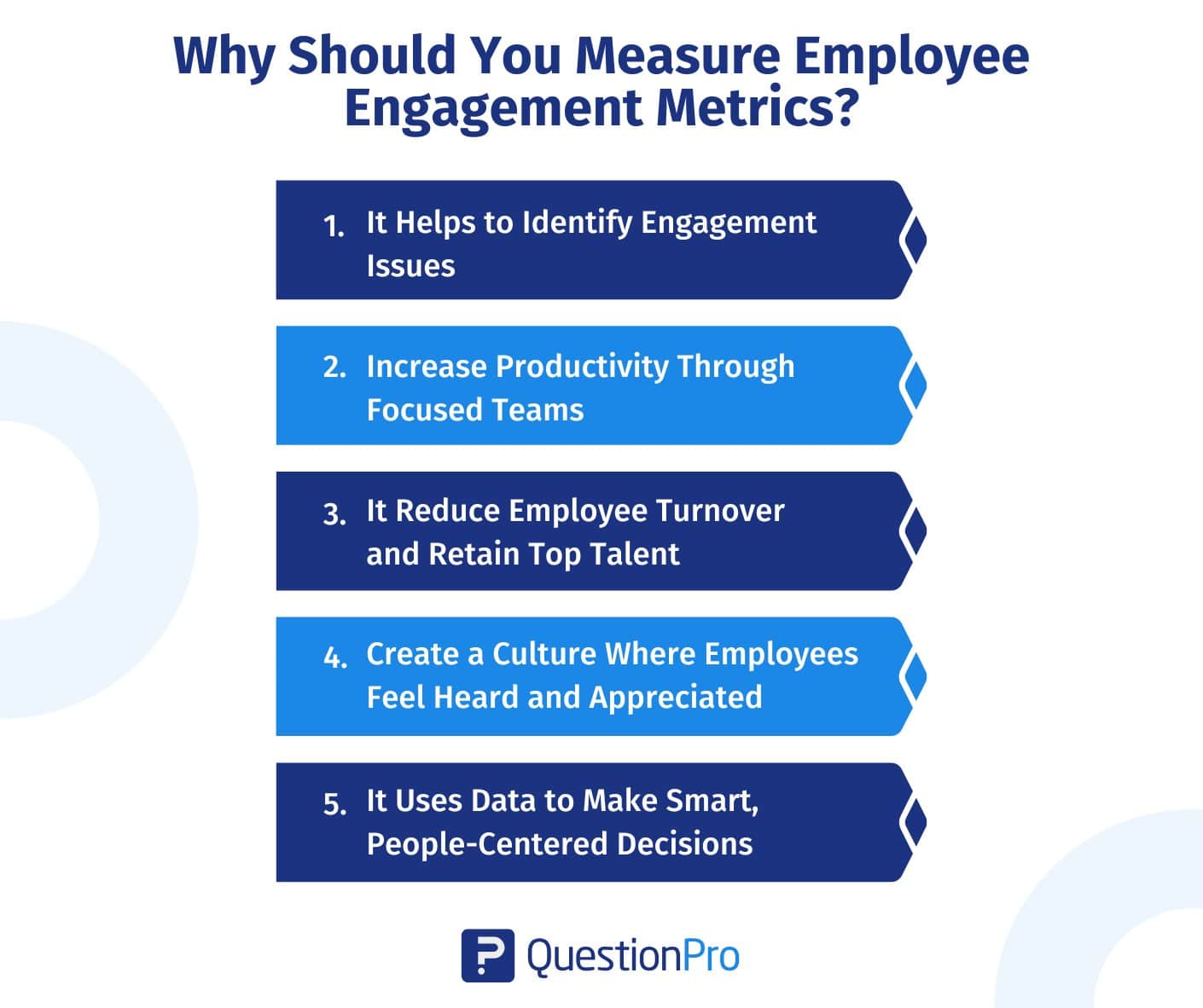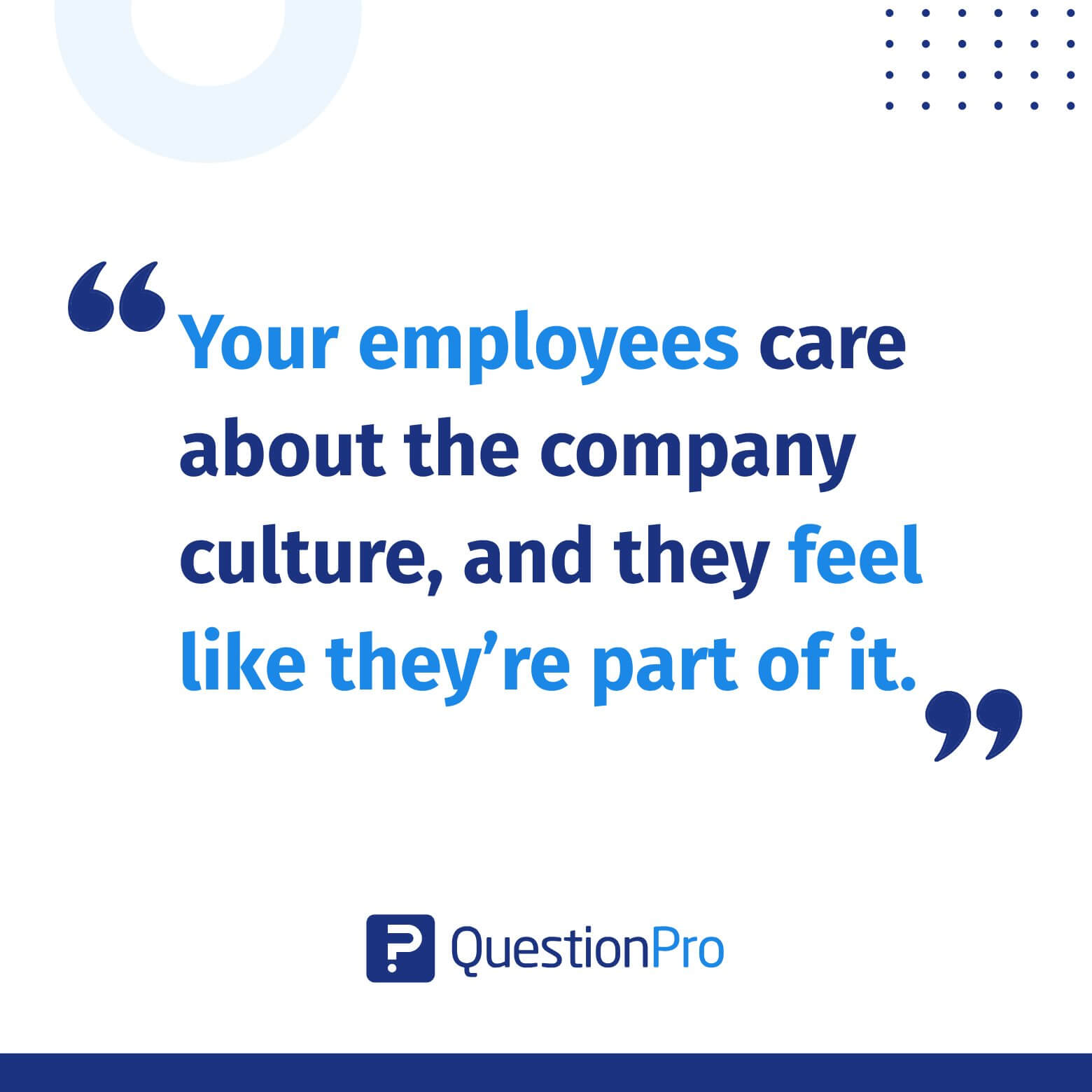
Employee engagement is the heartbeat of a thriving workplace. It reflects how connected, motivated, and committed your employees are to your organization’s goals. To truly understand this, you need more than just intuition; you need clear and reliable employee engagement metrics that reveal what’s working and what needs improvement.
These key metrics help you gain insight into employee satisfaction, customer satisfaction, morale, and alignment with company values. By tracking the right data, you can make informed decisions, boost productivity, and foster a positive, people-first culture.
Let’s explore how you can accurately measure and increase employee engagement and turn insights into real improvements.
What are Employee Engagement Metrics
Employee engagement metrics are the numbers and data points that help you understand how connected, motivated, and satisfied your employees feel at work. These metrics give you a way to measure how engaged your team really is, not just guess based on mood or assumptions.
Instead of relying on gut feelings, companies use these metrics to see if their employees are happy, feel valued, and are willing to go the extra mile. The higher the engagement, the more likely employees are to stay with the company, do great work, and contribute to a positive workplace culture.
Think of it like checking the health of your team. Just as you might track your steps, heart rate, or sleep to stay healthy, use engagement metrics to track things like employee satisfaction, feedback response rates, or productivity levels to keep your teams engaged and performing well.
These insights are especially helpful for HR professionals and managers who want to improve communication, reduce turnover, and build a stronger work environment.
Why Should You Measure Employee Engagement Metrics?
Employee engagement isn’t just about how happy people seem during meetings or how often they smile in the hallway. It’s about how motivated, committed, and connected they feel to their work and to your company.
Tracking employee engagement metrics gives you real insight into what’s going on beneath the surface. It helps you understand what’s driving success and what might be holding your team back.
Here’s why it matters:

1. It Helps to Identify Engagement Issues
By keeping an eye on engagement data, you can catch early signs of disengagement, such as an employee seeming less interested in projects. Maybe participation in team activities drops. Or maybe productivity dips just a little.
These small warning signs, if ignored, can lead to bigger problems like decreased productivity, poor team collaboration, or high turnover.
2. Increase Productivity Through Focused Teams
Engaged employees are more focused, enthusiastic, and committed to their work. They take initiative, complete tasks more efficiently, and are more likely to support their teammates.
By tracking engagement metrics, you’ll learn which teams are firing on all cylinders and which ones might need a boost. That way, you can support them before things get off track.
3. It Reduce Employee Turnover and Retain Top Talent
Losing good employees is expensive and disruptive. Measuring engagement helps you understand what keeps employees loyal and why they leave.
You’ll uncover insights into:
- What motivates your team
- Where they feel stuck
- What makes them feel valued
With that knowledge, you can design better retention strategies that are actually based on what your employees care about.
4. Create a Culture Where Employees Feel Heard and Appreciated
People don’t want to feel like a number. They want to feel heard.
When you consistently ask for feedback through surveys, pulse checks, or one-on-ones, you send a clear message:
“We care about what you think, and we’re listening.”
This builds trust, creates better communication, and helps foster a culture where employees know their voices make a difference.
And when people feel heard? They’re more likely to stay engaged and committed.
5. It Uses Data to Make Smart, People-Centered Decisions
Guesswork might work for picking a lunch spot, not for managing a team.
Employee engagement metrics give you clear, actionable data about how your people are doing. With that information, you can design programs and policies that actually solve real problems.
For example, you might decide to:
- Update onboarding to make it more supportive
- Train managers to communicate more effectively
- Offer flexible schedules to help with work-life balance
- Launch wellness programs based on employee feedback
When your decisions are based on real insights, they’re more impactful—and more likely to succeed.
15 Essential Employee Engagement Metrics
Tracking employee engagement is no longer optional; it’s essential. In today’s fast-paced work environment, businesses that measure and improve employee engagement are more likely to attract top talent, boost productivity, and maintain a positive workplace culture.
Companies that regularly monitor how employees feel about their work are more likely to:
- Attract and keep top talent
- Improve team productivity
- Build a positive, thriving company culture
So, what should you actually be tracking?
Here’s a list of the 15 most important employee engagement metrics to keep an eye on this year:
1. Employee Net Promoter Score (eNPS)
The Employee Net Promoter Score (eNPS) is the most important metric and tells you how likely your team is to recommend your company as a great place to work. It’s a quick way to assess overall employee sentiment. A high eNPS score usually means employees are happy, engaged, and proud to be part of your team.
Just ask one simple question:
“On a scale of 0 to 10, how likely are you to recommend this company as a place to work?”
Once you collect the responses:
- Promoters: People who answer 9 or 10
- Detractors: People who answer between 0 and 6
- Passives: People who answer 7 or 8 (these don’t factor into the score)
The Formula:
eNPS = % of Promoters – % of Detractors

2. Employee Satisfaction Score
The Employee Satisfaction Score measures how content your team feels with their daily work, responsibilities, and the overall environment they operate in.
You can use quick pulse surveys or anonymous questionnaires to gather feedback. Ask simple, direct questions like:
“On a scale of 1 to 5, how satisfied are you with your role right now?”
3. Employee Retention Rate
The Employee Retention Rate tracks the percentage of employees who choose to stick with your company over a given time period. It’s a direct reflection of how connected and engaged your workforce feels.
Here’s the simple formula:
Retention Rate = (Total employees – Employees who left) ÷ Total employees × 100

For example, if you started the year with 100 employees and 10 left, your retention rate would be 90%.
4. Turnover Rate
While retention shows who stays, turnover reveals who’s leaving and how often they’re leaving. Tracking this helps you pinpoint when and why employees are exiting, especially if high-performing individuals are resigning.
If retention tells you who’s staying, turnover reveals who’s leaving and how often they’re leaving.
Don’t just lump all turnover together. Break it down into:
- Voluntary Turnover: Employees who choose to leave (this is often linked to engagement issues)
- Involuntary Turnover: Layoffs or terminations (this usually reflects business or performance decisions)
Tracking both gives you a clearer picture of what’s really happening.
5. Absenteeism Rate
When employees start missing work more often, it’s usually not random. Frequent absences can be a silent signal of disengagement, burnout, or even deeper cultural problems. That’s why tracking your Absenteeism Rate matters.
Use this formula to measure it:
Absenteeism Rate = (Total days missed ÷ Total workdays scheduled) × 100
A high absenteeism rate might mean:
- Employees are stressed or overwhelmed
- Teams feel disconnected from their work
- There’s low motivation or poor work-life balance
On the other hand, low absenteeism typically indicates an engaged and energized workforce.
6. Employee Participation Rate in Engagement Activities
This metric measures the level of employee engagement in your company’s initiatives, including employee surveys, wellness programs, town halls, social events, training sessions, and team-building activities. Participation rates reveal how invested your employees are in the culture and community of the workplace.
High participation sends a strong message:
Your employees care about the company culture, and they feel like they’re part of it.

If you’re consistently seeing low turnout, it could be a sign of:
- Lack of trust or psychological safety
- Poor communication
- Burnout or general disengagement
7. Internal Mobility Rate
The Internal Mobility Rate measures how often employees move to new roles or are promoted within your organization.
Use the following formula to calculate the internal mobility rate:
Internal Mobility Rate = (Number of internal moves ÷ Average number of employees) × 100
When internal mobility is high, it’s usually a sign of a healthy workplace. Your team sees growth opportunities and feels confident they can build their careers without leaving the company.
8. Performance and Productivity Scores
Performance metrics and productivity scores measure how well employees are doing their jobs in terms of quality, speed, and meeting goals. When employees feel engaged, they tend to be more motivated and focused, which leads to better results. Tracking these scores helps you understand how engagement influences day-to-day work and overall business success.
Performance isn’t one-size-fits-all. It’s a mix of both quality and quantity. Here’s what to keep an eye on:
- Output Volume: How much work is being completed within a given timeframe?
- Goal Completion Rate: Are employees meeting individual or team targets?
- Quality of Work: Is the work accurate, thorough, and up to company standards?
- Efficiency: How quickly and effectively tasks are completed without sacrificing quality.
- Feedback from Managers and Peers: Qualitative insights on how employees perform and collaborate.
9. Feedback and Recognition Frequency
Everyone wants to feel like their work matters. That’s why feedback and recognition play such a big role in keeping employees engaged.
This metric is about how often people receive meaningful feedback, both the kind that helps them grow and the kind that simply acknowledges their efforts, such as “Hey, great job.”
When feedback happens regularly, employees know:
- What they’re doing well
- Where they can improve
- That their efforts are actually noticed
And when people feel seen and appreciated, they naturally become more motivated and committed to their work.
But if feedback is rare or recognition feels like an afterthought?
That’s when employees start to feel disconnected or unimportant. Over time, that can drain engagement.
Building a culture where feedback and recognition occur frequently requires consistency. When employees hear “thank you” or “here’s how you can get even better” on a regular basis, they’re much more likely to stay engaged and do their best work.
10. Manager Effectiveness Rating
It’s no secret that managers make or break the employee experience.
A great manager can inspire, support, and guide their team to do amazing work. This metric measures how employees rate their direct supervisors in terms of communication, support, and leadership.
The easiest way is to include questions about management in your engagement surveys. For example:
- Does your manager give you clear direction?
- Do you feel supported in your role?
- Does your manager recognize your work and help you grow?
When employees rate their managers honestly, you can get a clear view of where leadership is strong and where it needs improvement.
11. Work-Life Balance Rating
The Work-Life Balance Rating helps you understand how your team feels about balancing their job with the rest of their life. This includes factors like flexible working hours, workload, time off, and overall stress levels.
This isn’t just about asking, “Are you happy with your hours?”. You need to look at the full picture:
- How do employees rate their current workload?
- Do they feel they have flexibility in their schedules?
- Are they constantly working overtime?
- Are they actually using their vacation days?
The easiest way is through anonymous surveys or regular pulse checks. Ask questions like:
- How would you rate your current work-life balance?
- Do you feel supported in setting healthy boundaries at work?
- Are you experiencing signs of stress or burnout?
12. Training and Development Participation Rate
The Training and Development Participation Rate measures the percentage of employees who participate in learning opportunities provided by the organization. This includes workshops, online courses, certifications, leadership programs, and any other skill-building activities.
When employees stop learning, they eventually stop growing. Employees who actively participate in training feel like the company is investing in their future. That builds loyalty, motivation, and a sense of purpose.
When you track participation rates, you’ll know whether your learning programs are hitting the mark or if they need to be more accessible, better promoted, or better aligned with employee goals.
13. Job Satisfaction Metrics
How happy are your employees with their day-to-day work? Job Satisfaction Metrics can help you figure out that. You can understand how happy and content employees are with their roles, responsibilities, and overall work environment.
To measure job satisfaction, use employee satisfaction surveys with straightforward questions like:
- How satisfied are you with your current role?
- Do you find your work meaningful?
14. Alignment with Company Values
Alignment with Company Values measures how well employees connect with and embody the organization’s core principles in their everyday work. It reflects whether employees understand and believe in the company’s mission, vision, and cultural values.
Today’s workforce, especially younger generations, wants more than just a paycheck. They want to be part of something meaningful. When employees align with your values, engagement naturally increases. It builds trust, loyalty, and strengthens your employer brand.
Include questions like:
- Do you feel your work contributes to the company’s mission?
- Do the company’s values influence how you do your job?
Tracking this metric helps you ensure your culture isn’t just words on a page but something your team truly embraces.
15. Survey Response Rates and Quality
If your employee engagement surveys are getting ignored or rushed through, it’s a red flag. It means employees aren’t engaged enough to take the time to share their thoughts honestly. High response rates with thoughtful feedback indicate employees care and want to be heard.
Keep surveys short, focused, and relevant. When employees see surveys as valuable, they’re more likely to engage and share honest feedback.
Here is what to Track:
- Response rate: The percentage of employees who complete the survey.
- Completion quality: Are the responses detailed or just neutral/skipped?
- Open-ended question depth: Are employees giving thoughtful feedback?
- Trends in tone: Are comments positive, negative, or indifferent?
How to Measure Employee Engagement with QuestionPro
Measuring employee engagement doesn’t have to be complicated. With QuestionPro, you get a powerful set of tools that make it easy to understand how connected and committed your employees really are.
Here’s how QuestionPro helps you get clear, actionable insights:
- Ready-to-Use Survey Templates
No need to start from scratch. QuestionPro offers pre-built employee engagement survey templates based on proven models. They’re fully customizable to fit your company’s unique culture and goals.
- Employee Net Promoter Score (eNPS) Module
Want to track employee loyalty? The dedicated eNPS module automatically calculates scores and lets you monitor changes over time, so you always know how your team feels about recommending your company as a great place to work.
- Pulse Surveys for Real-Time Feedback
Engagement is always evolving, so staying in tune matters. You can use pulse surveys to conduct quick and frequent check-ins with your team. Schedule them automatically and watch engagement trends unfold in real time.
- 360-Degree Feedback Surveys
360-degree feedback surveys collect input from peers, managers, subordinates, and even external collaborators. This well-rounded approach gives employees insights into how they’re perceived across different roles and relationships, promoting personal growth and stronger team dynamics.
- Anonymity and Confidentiality
Honest feedback requires trust. QuestionPro supports both anonymous and confidential surveys, giving employees the confidence to share openly without worry.
- Text and Sentiment Analysis
Open-ended responses can hold a wealth of insights. Using natural language processing (NLP), QuestionPro analyzes the emotional tone behind feedback. This helps you understand not just what employees say, but how they feel.
- Smart Survey Logic and Branching
Keep surveys relevant and engaging with advanced logic and branching features. Questions adapt based on responses, creating a personalized experience that feels thoughtful and targeted.
Conclusion
Employee engagement helps create a stronger and more productive organization. All the employee engagement metrics provide a genuine insight into how your team feels.
When organizations invest in measuring engagement consistently and act on the results, they build trust, boost morale, and improve team performance. Keep listening, measuring, and most importantly, keep improving employee engagement metrics. Because a highly engaged workforce doesn’t just happen; it’s built with intention, insight, and action.
With powerful tools for surveys, real-time feedback, 360-degree reviews, and engagement tracking, QuestionPro gives you everything you need to create a workplace where people feel heard, appreciated, and ready to give their best.
Ready to build a stronger, more engaged team?
Frequently Asked Questions (FAQs)
Answer: Employee engagement metrics help you understand how connected and motivated your employees feel. Tracking these metrics lets you identify what’s working, where people are struggling, and how you can create a better workplace culture.
Answer: It’s best to take a continuous approach. Many companies run an annual engagement survey, but adding pulse surveys or quarterly check-ins gives you a more accurate, real-time view of engagement trends.
Answer: Use surveys, performance reviews, eNPS scores, and feedback tools to gather insights regularly. Consistency and follow-up actions are key.
Answer: Higher engagement leads to better productivity, innovation, and customer satisfaction, ultimately improving business results.
Answer: QuestionPro offers pre-built surveys, eNPS tracking, pulse surveys, 360-degree feedback tools, and real-time analytics. Plus, features like sentiment analysis and confidential responses help you collect honest, actionable feedback.







